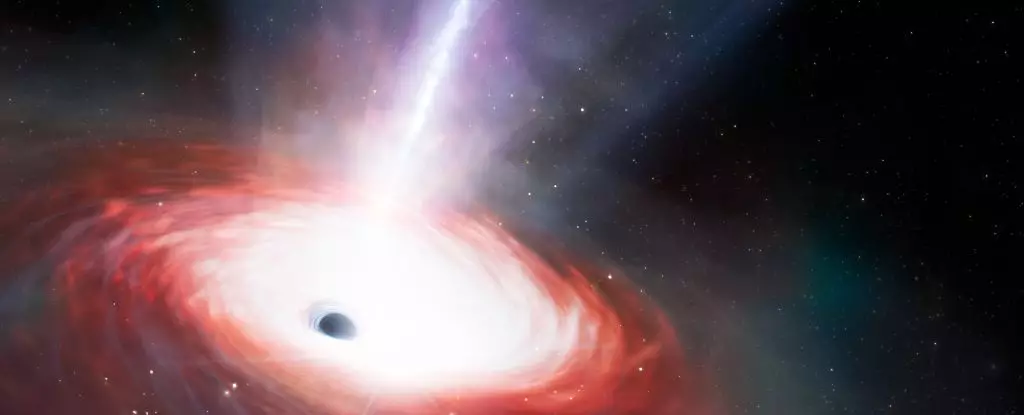In a groundbreaking discovery, astronomers have unveiled a remarkable supermassive black hole in a galaxy named LID-568, existing just 1.5 billion years after the Big Bang. This black hole stands out as one of the most voracious we have ever observed, consuming material at an astonishing rate exceeding the Eddington limit by over forty times. This phenomenon sheds light on one of the most enduring enigmas of cosmology: how supermassive black holes can amass such immense masses so rapidly in the primordial Universe.
Research led by astronomer Julia Scharwächter at the Gemini Observatory and NSF’s NOIRLab highlights that this new understanding of black hole behavior could be pivotal in explaining their formation and evolution in the early epochs of the cosmos. The extreme feeding habits of the LID-568 black hole call for a reevaluation of our current models regarding black hole growth, particularly those formed shortly after the Big Bang.
At the core of this discovery lies the fundamental concept of the Eddington limit, a theoretical cap on the rate at which a black hole can accrete matter without expelling it through radiation pressure. As material spirals into a black hole, it forms an accretion disk that heats up under intense friction, emitting luminous radiation. This outward radiation pressure counteracts the inward force of gravity. When the forces balance out, the system reaches the Eddington limit, effectively halting further material from spiraling inward.
However, the existence of super-Eddington accretion—where a black hole exceeds this limit—introduces a new dynamic. In such scenarios, the black hole can ‘feed’ significantly faster than predicted, suggesting that during the infancy of the Universe, certain black holes could have undergone explosive growth. This phenomenon implies that mechanisms allowing for such prolific feeding must have been prevalent in the early cosmos, contributing to the formation of these behemoths in a remarkably short time frame.
The team of researchers, including Hyewon Suh from the same observatory, utilized the capabilities of the James Webb Space Telescope (JWST) to perform detailed follow-up observations of LID-568. This galaxy was a target because it emitted bright X-rays detected by the Chandra X-ray Observatory but appeared dim in optical wavelengths, presenting a unique challenge for astronomers trying to assess its intrinsic characteristics.
Despite its faintness, the scientific team employed the NIRSpec instrument on JWST to pinpoint LID-568’s location across the cosmic expanse. Their observations indicated that this elusive galaxy, while faint, emitted tremendous intrinsic brightness, indicative of a powerful and energetic supermassive black hole at its center. Features such as outflows of material, often associated with active accretion processes, were also prominently observed, supporting the theory that the black hole was in a state of extreme feeding.
Interestingly, this particular supermassive black hole is relatively modest in mass, weighing in at approximately 7.2 million times that of our Sun. However, the luminosity at which this black hole operates raises compelling questions. The amount of light generated by the surrounding accretion disk far surpasses the expected output for a black hole of this mass, indicating an accretion rate that is breathtakingly higher than the Eddington limit.
Such an elevated rate hints at brief but intense periods of super-Eddington accretion, suggesting that the team caught the black hole in a fleeting moment of unprecedented growth. This occurrence emphasizes the rarity of such observations and their potential to inform future studies regarding the evolution of supermassive black holes.
As ongoing studies of LID-568 continue, astronomers anticipate that it will become a focal point for investigating supermassive black holes and their formation mechanisms. The understanding gleaned from this and similar observations may facilitate uncovering the mysteries surrounding the early Universe, where galaxies and their central black holes first began to take shape.
The potential existence of super-Eddington accretion mechanisms adds a new dimension to our understanding of these cosmic giants. Instead of forming through traditional stellar collapse, the earliest supermassive black holes may have emerged from enormous gas clouds collapsing under their own gravity, leading to accelerated growth under extreme conditions—a concept that challenges previously held notions in astrophysics.
LID-568 presents not just an exciting glimpse into the Universe’s history but also a promising avenue for unraveling the complexities of black hole formation and evolution in the cosmic timeline. With future observations and analyses, we stand on the brink of deeper understanding of the intricate tapestry of our Universe.


Leave a Reply